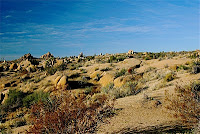The Colorado desert
Walking across the skillet of the Colorado desert in early afternoon is not for everyone, even on a March day, when temperatures hover around eighty in the shade. There is no shade to be found here, however. I had been walking an hour from Lost Palms Oasis, with another hour of hiking before I reached my car. I had plenty of water and snacks, and an orange I was saving for a special treat. I felt great. This was the longest and best hike of my stay in Joshua Tree.I had gotten up early to drive thirty miles from the northern part of Joshua Tree to the southern region. My purpose was twofold: to see the difference between the two desert ecologies and to take the 7.2 mile hike to Lost Palms oasis. The elevation dropped twelve hundred feet, and I left the higher mojave desert to explore the Colorado, a portion of the Sonoran desert. During the drive, Frank Morgan's saxophone magic flowed like warm honey from the car speakers. I passed a pick-up truck going north and hauling a powerboat.
As I worked through my last liter of water, my thoughts drifted off the trail and back in time. Whenever I'm in the southwest, I wonder how the first white men survived. What was it like on horseback, looking across the vast expanse of desert, seeing no sign of life, wondering where the next water could be found? The Cahuillas Indians used every plant and animal to advantage as they carved out an existence in the desert.
 Ocotillo cactus blooms in the Colorado desert
Ocotillo cactus blooms in the Colorado desert The bad land of the Colorado desert
The bad land of the Colorado desert The rare lizard that remained still for a photo
The rare lizard that remained still for a photo
Cholla cactus in the mojave desert
The Colorado desert struck me as somehow more harsh than the mojave. It seemed more bleak, more forbidding and more dangerous. I think that the miles of Joshua trees, which are found only in the mojave desert, somehow soften the environment. They stand there, like comical Dr. Seuss characters, posing, begging a photograph. "Look at me! Take my picture!" There is, of course, nothing frivolous about the mojave. The Joshua trees are beautiful; perhaps their beauty helps to mask the dangers that every desert holds.I encountered people on the trail frequently enough, but when I reached the last two tenths mile, a steep descent into the canyon that held the oasis, I was suddenly alone. Loose gravel and a steep slope made the going tricky; it was a long way down. Once in the oasis, I wandered deeper into the canyon until I found what I was seeking - solitude. I had lunch on a rock shaded by the massive desert fan palms. A cool breeze played the palm fronds like some exotic instrument. A cactus wren sang somewhere in the green bushes. I found what I had come for.
 Lost Palms Oasis
Lost Palms Oasis Lost Palms Oasis
Lost Palms OasisThat night, a coyote visited my campsite, more interested in my trash than in me. I caught him in the beam of my flashlight as he pranced left and right, as light on his feet as Gene Kelly singing in the rain. He stopped and looked right into the light, wary of the source, I imagine, but not wanting to give up on his find. I asked him to leave, and he did.




No comments:
Post a Comment